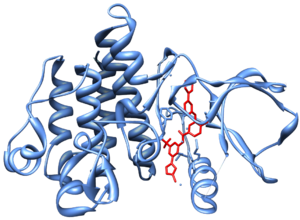Tyrosine kinase inhibitor
Topic: Chemistry
 From HandWiki - Reading time: 4 min
From HandWiki - Reading time: 4 min
A tyrosine kinase inhibitor (TKI) is a pharmaceutical drug that inhibits tyrosine kinases. Tyrosine kinases are enzymes responsible for the activation of many proteins by signal transduction cascades. The proteins are activated by adding a phosphate group to the protein (phosphorylation), a step that TKIs inhibit. TKIs are typically used as anticancer drugs. For example, they have substantially improved outcomes in chronic myelogenous leukemia. They have also been used to treat other diseases, such as idiopathic pulmonary fibrosis.
They are also called tyrphostins, the short name for "tyrosine phosphorylation inhibitor", originally coined in a 1988 publication,[1] which was the first description of compounds inhibiting the catalytic activity of the epidermal growth factor receptor (EGFR).
The 1988 study was the first demonstration of a systematic search and discovery of small-molecular-weight inhibitors of tyrosine phosphorylation, which do not inhibit protein kinases that phosphorylate serine or threonine residues and can discriminate between the kinase domains of the EGFR and that of the insulin receptor. It was further shown that in spite of the conservation of the tyrosine-kinase domains one can design and synthesize tyrphostins that discriminate between even closely related protein tyrosine kinases such as EGFR and its close relative HER2.[2][3]
Development of drugs
Numerous TKIs aiming at various tyrosine kinases have been generated by the originators of these compounds and proven to be effective anti-tumor agents and anti-leukemic agents.[4][5] Based on this work imatinib was developed against chronic myelogenous leukemia (CML)[6] and later gefitinib and erlotinib aiming at the EGF receptor. Dasatinib is a Src tyrosine kinase inhibitor that is effective both as a senolytic and as therapy for CML.[7]
Sunitinib, an inhibitor of the receptors for FGF, PDGF and VEGF is also based on early studies on TKIs aiming at VEGF receptors.[8]
Adavosertib is a Wee1 kinase inhibitor that is undergoing numerous clinical trials in the treatment of refractory solid tumors.[9] However, toxicities such as myelosuppression, diarrhea, and supraventricular tachyarrhythmia have arisen while attempting to determine the toxicity and effectiveness of the drug.[10]
Lapatinib, FDA approved for treatment in conjunction with chemotherapy or hormone therapy, is also currently undergoing clinical trials in the treatment of HER2-overexpressing breast cancers as it is suggested intermittent high-dose therapy might have better efficacy with manageable toxicity than the standard continuous dosing. A Phase I clinical trial found responses and dramatic responses to this line of treatment, with the most common toxicity being diarrhea.[11]
Mechanisms
TKIs operate by four different mechanisms: they can compete with adenosine triphosphate (ATP), the phosphorylating entity, the substrate or both or can act in an allosteric fashion, namely bind to a site outside the active site, affecting its activity by a conformational change.[12] Recently TKIs have been shown to deprive tyrosine kinases of access to the Cdc37-Hsp90 molecular chaperone system on which they depend for their cellular stability, leading to their ubiquitylation and degradation.[13] Signal transduction therapy can also be used for non-cancer proliferative diseases and for inflammatory conditions.[14] An example is nintedanib for the treatment of idiopathic pulmonary fibrosis.[15]
See also
References
- ↑ "Blocking of EGF-dependent cell proliferation by EGF receptor kinase inhibitors". Science 242 (4880): 933–935. 1988. doi:10.1126/science.3263702. PMID 3263702. Bibcode: 1988Sci...242..933Y.
- ↑ "Tyrphostins. 2. Heterocyclic and alpha-substituted benzylidenemalononitrile tyrphostins as potent inhibitors of EGF receptor and ErbB2/neu tyrosine kinases". J Med Chem 34 (6): 1896–907. 1991. doi:10.1021/jm00110a022. PMID 1676428.
- ↑ "Selective inhibition of the epidermal growth factor and HER2/neu receptors by tyrphostins". J Biol Chem 268 (15): 11134–42. 1993. doi:10.1016/S0021-9258(18)82102-0. PMID 8098709.
- ↑ "Tyrphostin-induced inhibition of p210bcr-abl tyrosine kinase activity induces K562 to differentiate". Blood 82 (12): 3524–9. 1993. doi:10.1182/blood.V82.12.3524.3524. PMID 7505115.
- ↑ "Inhibition of acute lymphoblastic leukaemia by a Jak-2 inhibitor". Nature 379 (6566): 645–8. 1996. doi:10.1038/379645a0. PMID 8628398. Bibcode: 1996Natur.379..645M.
- ↑ "Effects of a selective inhibitor of the Abl tyrosine kinase on the growth of Bcr-Abl positive cells". Nat Med 2 (5): 561–6. 1996. doi:10.1038/nm0596-561. PMID 8616716.
- ↑ "Src Tyrosine Kinase Inhibitors: New Perspectives on Their Immune, Antiviral, and Senotherapeutic Potential". Frontiers in Pharmacology 10: 1011. 2019. doi:10.3389/fphar.2019.01011. PMID 31619990.
- ↑ "Flk-1 as a target for tumor growth inhibition". Cancer Res. 56 (15): 3540–5. 1996. PMID 8758924.
- ↑ "NCI drug dictionary adavosertib". 2 February 2011. https://www.cancer.gov/publications/dictionaries/cancer-drug/def/wee1-inhibitor-azd1775.
- ↑ "Phase I study of single-agent AZD1775 (MK-1775), a Wee1 kinase inhibitor, in patients with refractory solid tumors". Journal of Clinical Oncology 33 (30): 3409–15. October 2015. doi:10.1200/JCO.2014.60.4009. PMID 25964244.
- ↑ "Phase I dose-escalation study of 5-day intermittent oral lapatinib therapy in patients with human epidermal growth factor receptor 2–overexpressing breast cancer". Journal of Clinical Oncology 32 (14): 1472–79. May 2014. doi:10.1200/JCO.2013.52.1161. PMID 24711549.
- ↑ "Kinetics of inhibition by tyrphostins of the tyrosine kinase activity of the epidermal growth factor receptor and analysis by a new computer program". Mol. Pharmacol. 45 (4): 673–83. 1994. PMID 8183246.
- ↑ Polier (2013). "ATP-competitive inhibitors block protein kinase recruitment to the Hsp90-Cdc37 system". Nature Chemical Biology 9 (5): 307–312. doi:10.1038/nchembio.1212. PMID 23502424.
- ↑ "Tyrphostins and other tyrosine kinase inhibitors". Annu Rev Biochem 75: 93–109. 2006. doi:10.1146/annurev.biochem.75.103004.142657. PMID 16756486.
- ↑ "Vargatef EPAR". 20 January 2020. https://www.ema.europa.eu/en/medicines/human/EPAR/vargatef.
 |
 KSF
KSF
